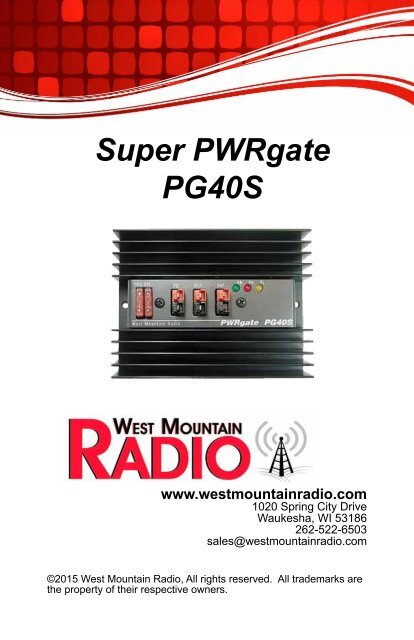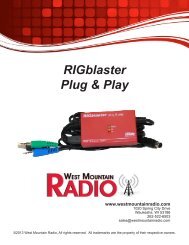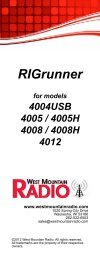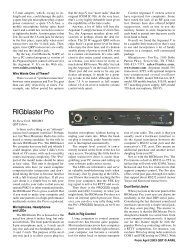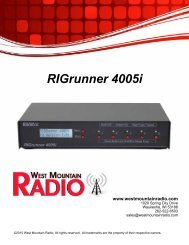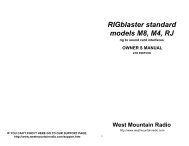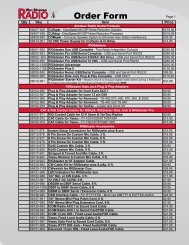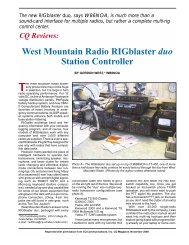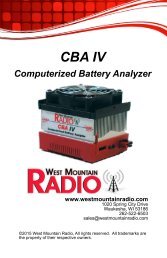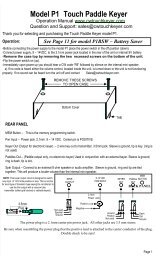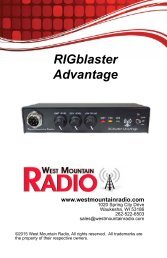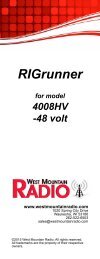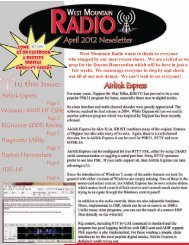Super PWRgate PG40S Owner's Manual - West Mountain Radio
Super PWRgate PG40S Owner's Manual - West Mountain Radio
Super PWRgate PG40S Owner's Manual - West Mountain Radio
Create successful ePaper yourself
Turn your PDF publications into a flip-book with our unique Google optimized e-Paper software.
<strong>Super</strong> <strong>PWRgate</strong><strong>PG40S</strong>www.westmountainradio.com1020 Spring City DriveWaukesha, WI 53186262-522-6503sales@westmountainradio.com©2015 <strong>West</strong> <strong>Mountain</strong> <strong>Radio</strong>, All rights reserved. All trademarks arethe property of their respective owners.
IntroductionThank you for choosing the <strong>Super</strong> <strong>PWRgate</strong> <strong>PG40S</strong>….the high power OR Gatewith a built-in four-stage battery charger. It makes a true solid-state UPS for theham shack.The <strong>Super</strong> <strong>PWRgate</strong> <strong>PG40S</strong> eliminates the danger of connecting a powersupply directly across a battery, which can damage many power supplies. The<strong>PG40S</strong> also avoids introducing hum and RF interference, caused by most leadacidbattery chargers, by using a standard power supply. Furthermore, most leadacidbattery chargers are designed for flooded lead-acid marine or automotivebatteries, and are inappropriate for charging sealed lead-acid gel and AGMtype batteries. The <strong>PG40S</strong> will extend the life span of a sealed lead-acid batterycompared to using a flooded lead- acid charger.The <strong>PG40S</strong> transfers 40 amperes at 12 volts DC in a continuous safe manner. Itconnects a battery and a power supply to a load, while electrically isolating boththe battery and the supply from each other. Whenever the power supply is on, thesupply feeds the load. It also charges the battery with a high-current four-statesafe battery charger. Whenever the power supply is off, the battery will feed theload. If either the power supply or the battery is malfunctioning, neither drawscurrent from the other. The switching is instantaneous.A <strong>PG40S</strong> is very useful in the ham shack, and even more useful in a repeaterinstallation. Communication equipment will remain operative during AC powerblackouts and power supply failures. Power supplies and batteries can beswapped out while equipment continues to be powered and without glitches.Additionally, the <strong>PG40S</strong> and a power supply may be used solely as apermanently installed battery charger. This also may be configured to run a radiostation directly from the battery.Please read the following instructions BEFOREinstalling the <strong>PG40S</strong><strong>West</strong> <strong>Mountain</strong> <strong>Radio</strong>2Operating <strong>Manual</strong>
Choosing a Mounting LocationPick a location that is close or central to the power supply, battery, as well asthe load or 12V distribution panel. <strong>Radio</strong>s and many 12V devices draw largeamounts of current. All wires have resistance, so it is good practice to keepthem as short as possible and to use a larger gauge wire to minimize voltagedrop.The <strong>PG40S</strong> can be installed in any orientation. It is recommend to use in a cooldry location and preferably well ventilated. Do not tightly enclose the unit as theheat sink can become quite warm under maximum current. At 40A continuouscurrent it will rise about 40 degrees Fahrenheit over ambient temperature infree air. If placed in direct sunlight, it will absorb heat and get unnecessarily hot.The <strong>Super</strong> <strong>PWRgate</strong> can be mounted using number 8 hardware in the twomounting holes.Connecting the power supplyUse a regulated power supply that is between 13.8 volts and 15 volts.Powerpole® connectors can be installed by soldering or crimping. Be sure tomake good connections. For detailed Powerpole® connector installation tips seeRIGrunner support pages at http://www.westmountainradio.com/ppinfo.The power supply wire should be heavy gauge and as short as possible;recommend #10 wire 3 feet to no longer than 6 feet long. Most power supplieshave 1/4 inch studs. Note that <strong>West</strong> <strong>Mountain</strong> <strong>Radio</strong> carries 3 and 6 feett longpower supply cables, #10 red and black insulated wire with ¼” in ring terminalson one end and Powerpole® on the other.Be sure to connect the RED Powerpole® connects to the RED wire andconnect to the PLUS terminal on the supply. Similarly, make sure that theBLACK Powerpole® connect to the BLACK wire and connect to the NEGATIVEterminal on the supply. Check that the connections at the power supply are welltightened.Plug this cable from the power supply into the <strong>Super</strong> <strong>PWRgate</strong> connectormarked PS (power supply). Confirm that the Powerpole® are plugged togethersecurely, and that the wire is straight at the connection point and is not understrain or bent over.<strong>West</strong> <strong>Mountain</strong> <strong>Radio</strong>3Operating <strong>Manual</strong>
Transceiver<strong>Super</strong> <strong>PWRgate</strong> PG40sPower SupplyBatteryConnecting the Load or Power StripAnderson Powerpole® are used for all <strong>Super</strong> <strong>PWRgate</strong> connections. See thesection “Powerpole® connector installation tips”.The load wire should be heavy gauge and as short as possible. If connectingdirectly to a radio or other device, you will need to install Powerpole® on thosecords. Modern radios use RED wire for positive, and BLACK wire for negative (orcommon or ground). Refer to the equipment manual if you have non-standardequipment. Plug this wire into the <strong>Super</strong> <strong>PWRgate</strong> terminal marked OUT.If you are connecting the output to a power strip, such as a RIGrunner, it isrecommended to use #10 wire, 3 feet to 6 feet long. At least one end will needPowerpole® installed; the other end can wire directly to the power strip oruse connectors. Note that <strong>West</strong> <strong>Mountain</strong> <strong>Radio</strong> carries 3 feet and 6 feet longextension cables, #10 red and black insulated wire, with Powerpole® on bothends.<strong>West</strong> <strong>Mountain</strong> <strong>Radio</strong>4Operating <strong>Manual</strong>
Plug this wire from the power strip or equipment into the <strong>Super</strong> <strong>PWRgate</strong>connector marked OUT (output). Confirm that the Powerpole® are pluggedtogether securely, and that the wire is straight at the connection and is not understrain or bent over.At this point, check out the system operation with the power supply. Turn on thepower supply and turn on the radio or equipment. The radio or equipment shouldproperly work.Connecting the BatteryAnderson Powerpole® are used for all <strong>Super</strong> <strong>PWRgate</strong> connections. See thesection “Powerpole® connector installation tips”.The battery wire should be heavy gauge and as short as possible; recommend#10 wire, 3 feet long. In addition, a fuse must be installed in the positive leaddirectly at the battery terminal. Note, any short in the battery wire, connector,or load could result in fire and battery explosion.Large batteries have side, post, or threaded terminals. Deep cycle, marine,AGM, and others usually have 3/8 inch and 5/16 inch studs. Therefore, it isrecommended to use a short 3 feet #10 wire, Powerpole® on one end, an in-linefuse (40 A max), and ring terminals for the battery end. <strong>West</strong> <strong>Mountain</strong> <strong>Radio</strong>carries a battery fuse kit, wire, and Powerpole®.BatteriesCaution: Handle batteries with knowledge and appropriate care. Batterieshave dangerous chemicals that can seep out. Batteries can emit extremelyexplosive hydrogen gas that is explosive. Batteries, especially automotiveand marine flooded lead acid, must be used in a strong, ventilatedenclosure. Sealed lead acid batteries are much safer but must be correctlyhandled with care.NEVER make the last connection directly to a battery causing a sparkthat could cause the battery to explode, sending debris and acid in alldirections. Batteries can get very hot when improperly charged or if a cellgets shorted. Batteries will explode during charging or discharging for avariety of reasons. Batteries are safe when handled properly.<strong>West</strong> <strong>Mountain</strong> <strong>Radio</strong>5Operating <strong>Manual</strong>
Choose a 12 volt battery with an ampere-hour rating according to your powerneeds. If the batteries are placed indoors they must be sealed for safety reasons.Again, it is very important to place a fuse at the positive battery terminal.This manual does not cover all the types of batteries, but for use in the hamshack a lead-acid types battery is recommended because they offer the bestprice to power ratio. Gelled cells and absorbed glass mat (AGM) batteries aresealed and are very safe. Some of these have a tiny positive pressure vent.Gelled cells are easiest to use with the <strong>Super</strong> <strong>PWRgate</strong> because the batterycharging circuit comes configured properly and matches a 13.8 volt powersupply. If using AGM batteries, it is suggested to slightly elevate the voltage forthe power supply, and add a jumper change inside the <strong>Super</strong> <strong>PWRgate</strong>. It is notrecommended to use any wet cell or a “starting” battery for automobiles. Use ofmarine deep-cycle batteries is only recommended if AGM or Gel type with solidplates.<strong>West</strong> <strong>Mountain</strong> <strong>Radio</strong> carries size 24 Gelled and AGM batteries, as well assmaller and larger batteries.System CheckoutWhen the power supply and battery are connected, and the <strong>Super</strong> <strong>PWRgate</strong> isdriving a radio, a quick checkout procedure should be followed:· Run your radio, and unplug the power supply. The radio should operatewithout interruption now from the battery.· Plug the power supply back in, and the radio will now be powered from thesupply. If you have an ammeter on the supply it will show current.It is recommended to use and in-line meter, such the Power Analyzer sold by<strong>West</strong> <strong>Mountain</strong> <strong>Radio</strong>. It measures volts, amperes, watts, ampere-hours, andwatt-hours simultaneously.Place the Power Analyzer in-line with the power supply to measure its output.Unplug the load from the <strong>Super</strong> <strong>PWRgate</strong> to measure the battery’s chargingcurrent. Plug the Power Analyzer into the <strong>Super</strong> <strong>PWRgate</strong>’s output to measureeither the power supply current if the supply is connected, or the battery’s outputcurrent if the supply is disconnected or is turned off.Refer to the charging circuit description to verify the different states whenmeasuring the charging current.<strong>West</strong> <strong>Mountain</strong> <strong>Radio</strong>6Operating <strong>Manual</strong>
VoltagesManufacturers list the lowest recommended DC supply voltage range for thespecific radio model. Some radios are listed as 13.8 VDC +- 15%, and others as13.8 VDC +-10%.12 volt power supplies are regulated to provide 13.8 volts DC. The <strong>Super</strong><strong>PWRgate</strong> has a diode in series that has a voltage drop of 0.25 V for 50 ma to0.30 V for 1 ampere and 0.50V at 40 amperes. Under normal load the <strong>Super</strong><strong>PWRgate</strong> output will be no less than13.5 volts.Fully charged 12 volt batteries exhibit around 13.5 volts open circuit. Whensupplying current, the battery’s internal resistance diminishes the voltage. Forinstance, a 70 A-h battery will drop to 12.3 volts at 10 amperes at half discharge.The <strong>Super</strong> <strong>PWRgate</strong> will give a drop of 0.3 volts at 1 ampere, thereby providing12.0 volts to the radio.Additional voltage drops can easily occur due to the high current and theresistance in the wires, the fuses, and the connectors. Therefore, it is imperativeto keep all wires as short as possible, as low of gauge as practical, and as fewconnectors as possible. Also use a large fuse on the battery, 30 or 40 amp tokeep its voltage drop low. Use a voltmeter to check the voltage at the radio whenrunning on battery power.<strong>Super</strong> <strong>PWRgate</strong> ChargerThe charging circuit is a four-state high-current battery charger. The chargingcircuit, which is always connected to the battery, uses the power supply as thecurrent source. It charges the battery automatically by knowing the battery’svoltage. It also changes charging state if the power supply goes from “off” to“on”, following a power outage, and it also changes state if the battery voltagedrops when supplying heavy current. These conditions are interrelated to provideproper charging automatically.The charger is a safe battery charger. It supplies the rated current if the batteryis heavily discharged. Current drops in a smooth and progressively diminishingmanner as the battery nears full charge. Note, that the charger is a feedbackdevice and it cannot overcharge a 12 volt battery. Also, it will not charge a batterythat has a dead cell.The charging circuit has four selectable charging current settings, 1A, 4A, 7A,and 10A, to be chosen appropriately for the battery’s rating.<strong>West</strong> <strong>Mountain</strong> <strong>Radio</strong>7Operating <strong>Manual</strong>
The charging circuit has four selectable charging current settings, 1A, 4A, 7A,and 10A, to be chosen appropriately for the battery’s rating.Typical Charging CurveGREEN LEDMAXCURRENTGREEN & RED LEDCheck forbad cellSwitch to Float@ 0.1 MAXGREEN & YELLOW LEDFLOAT CURRENTTIMEThe four charging states are:Trickle charge…If the battery is below 10 volts, then a low current of 50 ma issupplied. This is a safe current if the battery has a dead cell. But if the batteryis good, the voltage will slowly rise to above 10 volts and then the charger willswitch to the bulk charge state.Bulk Charge…. This is a high current state, selected by the maximum currentsetting (Fuse Jumper), and controlled by the battery’s voltage. The charger willprovide up to maximum current, limited by the circuit, the power supply voltage,and the battery’s impedance and voltage.Peak Voltage…. This is often called the “absorption” state. The battery ischarged with the voltage limit elevated to 13.8 V or 14.2 V (see below), untilthe current has diminished to a tenth of the maximum setting. At this current,the charger will change to the float state.Float….. This is the resting state of the charged battery, often called themaintenance state. The charger will supply sufficient current, up to themaximum selected current, to keep the battery at the float voltage of 13.5 V.<strong>West</strong> <strong>Mountain</strong> <strong>Radio</strong>8Operating <strong>Manual</strong>
The states are switched as follows:Turn-on…. If the power supply is turned on, and the battery had been dischargedbelow 10 volts, the charger will start in the trickle charge state, and then, if thebattery rises above 10 volts, it changes into the bulk charge state. If the voltagerises to above 12 volts, then the peak voltage state is entered. Then, when thecurrent has diminished to one-tenth of the maximum selected current, the floatstate is entered. If the battery is charged to over 13 volts, turning on the powersupply will cause the charger to remain in the float state.This turn on cycle occurs following a power outage.Discharging Battery…. If a load is placed on the battery, and the charger hadbeen in the float state, and the battery voltage stays above 13 volts, the chargerwill remain in the float state supplying up to full current. If the battery voltage isdischarged to less than 12 volts, and the load is removed, the charger will enterthe peak voltage and eventually the float state as above.If the radio station is connected directly to the battery and not through the <strong>Super</strong><strong>PWRgate</strong> output, then the battery will supply the load while the battery is beingcharged. In fact, the current will be shared between the load and the battery. Thismethod of powering a radio station was described by W1ZR in an article in QST,Dec 2003. See the diagram below for aW1ZR configuration.Transceiver<strong>Super</strong> <strong>PWRgate</strong> PG40sPower SupplyBattery<strong>West</strong> <strong>Mountain</strong> <strong>Radio</strong>9Operating <strong>Manual</strong>
LED IndicatorsGreen (ON)…. Indicates that the charger is fully active and will provide up tomaximum current to the battery according to the battery’s state. Note that thisLED does not measure nor indicate current flow, only the charger’s state, ie. “fullyactive state and would charge a battery if it were connected.“Green (ON) and RED (PK)…. Indicates that the charger is in the peak voltagestate (PK) and will provide up to maximum current to the battery. As the currentis diminishing the charger attempts to reach an elevated battery voltage. Whenthe current drops to one-tenth the maximum current setting the state changes tofloat.Green (ON) and Yellow (FL)…. Indicates that the charger is in the float state(FL) and will provide up to maximum current to the battery to maintain the batteryat the float voltage of 13.5 volts.A typical charging curve is shown in the figure.Choosing and Setting the Maximum Charge CurrentThe charger has three internal current sensing resistors that can be activated fordetermining the maximum current limit. 40A fuses are used as the high currentswitch (need a high current jumper wire. The 40A fuse has the lowest resistanceof the ATC fuses and closely approximates a true jumper.) Note that leaving thefuses out provides a charge current of 1 ampere. To get different charging currentvalues install the fuses as follows.1 Ampere….. No fuse4 Amperes……Fuse in left socket7 Amperes…….Fuse in right socket10 Amperes……Fuse in both socketsUse the following charging current for the listed lead-acid battery ratings.Use 1 ampere for batteries from 3 to 12 Ah.Use 4 amperes for batteries from 13 to 32 Ah.Use 7 amperes for batteries from 33 to 50 Ah.Use 10 amperes for batteries from 51 Ah up.<strong>West</strong> <strong>Mountain</strong> <strong>Radio</strong>10Operating <strong>Manual</strong>
Advanced Charger ConsiderationsGelled CellsThe battery charger uses the station power supply. For ham radio operators thisis usually a 13.8 volt supply. Because of circuit components, this limits the peakcharge voltage to around 13.6 volts, which is slightly less than a desired 13.8 voltsfor a gelled cell’s peak. This results in a slightly low absorption state. The battery’scharge, therefore, will be a few percent less than maximum available amperehours.To achieve optimum battery charging, the power supply should be adjusted to14.10 volts dc. The charger will now permit the battery to reach a peak voltage of13.8 volts during the peak voltage cycle. The float state will remain at 13.5 Volts.Note: Always use a accurate digital display voltmeter to assure accuratereadings.AGM CellsThe charger can also be configured for an AGM type sealed battery. To do thisprecisely, the power supply should be re-adjusted to provide 14.50 volts. Inaddition, a jumper must be installed at J1 inside the <strong>Super</strong> <strong>PWRgate</strong>. Take thetop cover off. The small blue jumper block should be lifted off the pin and reinstalledshorting out the two pins. The charger will now permit the battery toreach a peak voltage of 14.2 volts during the peak voltage cycle. The float stateremains at 13.5 volts.Note: Always use a accurate digital display voltmeter to assure accuratereadings.Note that all major radio manufacturers specify that their radios will operate up to15 Volts DC. Therefore using the <strong>Super</strong> <strong>PWRgate</strong> at an elevated voltage of 14.5volts is fine.<strong>West</strong> <strong>Mountain</strong> <strong>Radio</strong>11Operating <strong>Manual</strong>
SpecificationsMaximum Voltage: 18 Volts DCMaximum Current: 40 AmperesCircuit:Diode OR-GateDiodes:Two Schottky 80 Ampere, 20 VoltVoltage Drop: 0.25 VDC Quiescent0.37 VDC at 40 AmperesCharging Circuit: Charging regulator ICField Effect Pass TransistorSchottky DiodeFuse switched for 1, 4, 7, or 10 Amperes( +2,-8%) maximumPeak voltage limit: 13.8 (Gelled Cells),14.2 (AGM), (+,-2%)Peak voltage terminate point: 1/10 maximum currentFloat Voltage: 13.5 volts (+,-2%)Reference voltages are temperature compensatedConnectors: Anderson Powerpole®, 40ASize:5.25 x 3.90 x 1.65 in, 13.4 x 9.9 x 4.2 cmWeight:0.9 lbs, 0.4 kgMounting Holes: Two, 0.175 d, at 4.875 in. distance, for #8 hardware<strong>Super</strong> <strong>PWRgate</strong> <strong>PG40S</strong> Warranty<strong>Super</strong> <strong>PWRgate</strong> <strong>PG40S</strong> is warranted against failure due to defects in workmanship ormaterials for one year after the date of purchase from <strong>West</strong> <strong>Mountain</strong> <strong>Radio</strong>. Warranty doesnot cover damage caused by abuse, accident, misuse, improper or abnormal usage, failure tofollow instructions, improper installation, alteration, lightning, or other incidence of excessivevoltage or current. If failure occurs within this period, return the <strong>Super</strong> <strong>PWRgate</strong> <strong>PG40S</strong> oraccessory to <strong>West</strong> <strong>Mountain</strong> <strong>Radio</strong> at your shipping expense. The device or accessory willbe repaired or replaced, at our option, without charge, and returned to you at our shippingexpense. Repaired or replaced items are warranted for the remainder of the original warrantyperiod. You will be charged for repair or replacement of the <strong>Super</strong> <strong>PWRgate</strong> <strong>PG40S</strong> oraccessory made after the expiration of the warranty period.<strong>West</strong> <strong>Mountain</strong> <strong>Radio</strong> shall have no liability or responsibility to customer or any other personor entity with respect to any liability, loss, or damage caused directly or indirectly by use orperformance of the products or arising out of any breach of this warranty, including, but notlimited to, any damages resulting from inconvenience, loss of time, data, property, revenue,or profit, or any indirect, special incidental, or consequential damages, even if <strong>West</strong> <strong>Mountain</strong><strong>Radio</strong> has been advised of such damages.Except as provided herein, <strong>West</strong> <strong>Mountain</strong> <strong>Radio</strong> makes no express warranties and anyimplied warranties, including fitness for a particular purpose, are limited in duration to thestated duration provided herein.www.westmountainradio.com1020 Spring City Drive, Waukesha, WI 53186tel 262-522-6503 fax 262-522-6504


